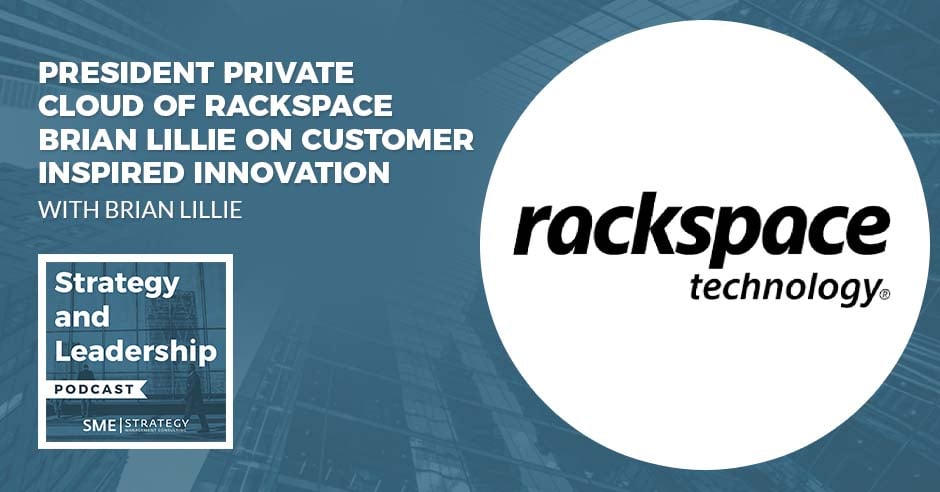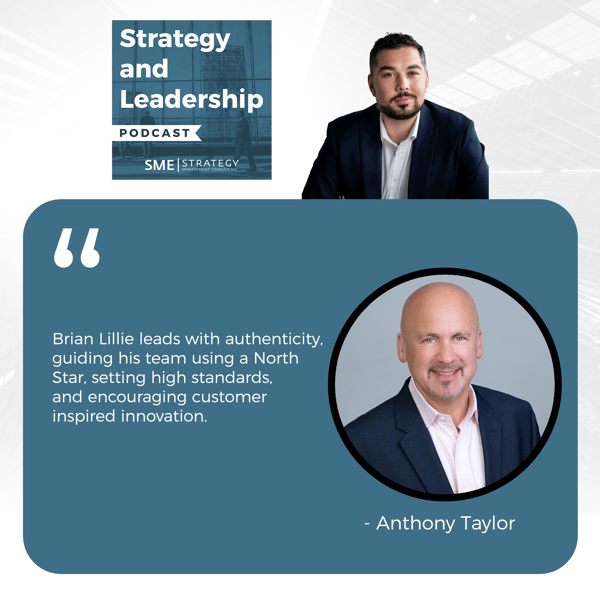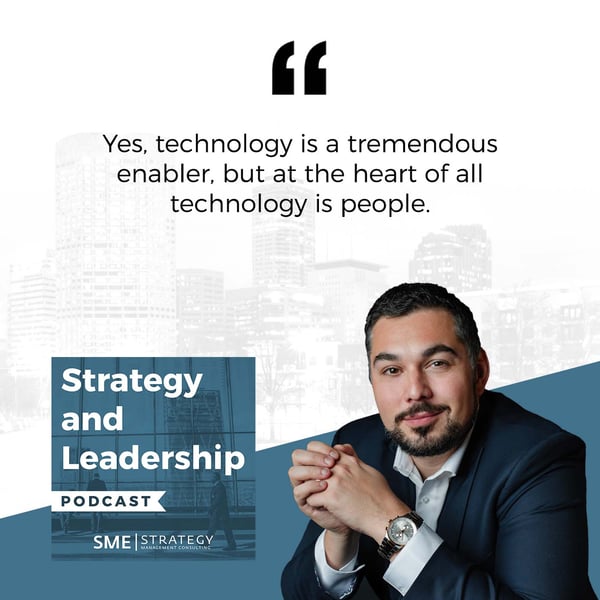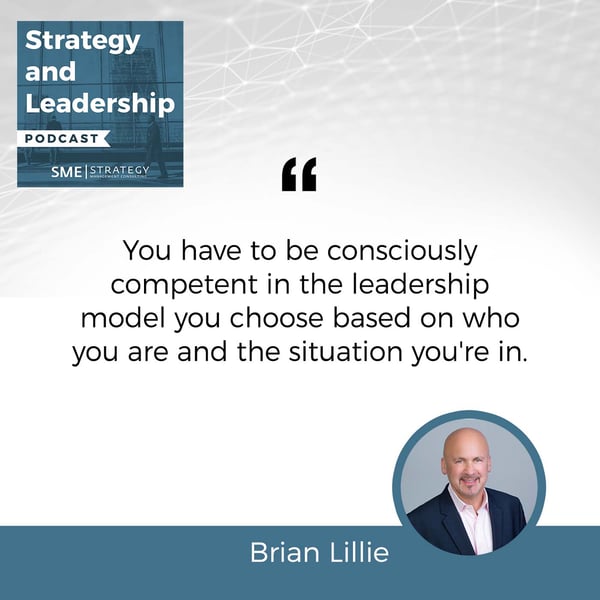President Private Cloud Of Rackspace - Brian Lillie On Customer Inspired Innovation

Customer inspired innovation is the belief that when you listen to your customers, they will guide you where you need to go. This is what our Brian Lillie, the President of Private Cloud at Rackspace, explains to us today along with his profound insights on leadership and the evolving landscape of technology. With a background spanning the US Air Force and various leadership roles, Brian emphasizes the crucial balance between customer-inspired innovation and tech push. He discusses the transformative potential of AI across industries, addressing macro trends and sustainability concerns. Brian advocates for setting high standards, fostering creativity, and creating a safe, caring environment. This episode is a compelling exploration of leadership, innovation, and the future of technology. Don’t miss out!
Listen on Spotify: https://open.spotify.com/episode/6WzH8e01VDx0Z5jL0X8nDV?si=YYggkMz5QBa4HoxqJETAKw
Listen on Apple Podcasts: https://podcasts.apple.com/ca/podcast/president-private-cloud-of-rackspace-brian-lillie-on/id1202449526?i=1000650474044
Want to continue the conversation with other leaders around the world? Join our Strategy and Leadership community.
https://strategy-and-leadership.mn.co
► Subscribe to our channel for weekly videos on strategy & leadership: https://www.youtube.com/channel/UCOHLNRrpk3rGUdg7qUQjiog/?sub_confirmation=1
➡️ Looking for a sample agenda for your strategic planning offsite? https://www.smestrategy.net/blog/sample-strategic-planning-agenda
// Connect with us:
► Contact us: https://www.smestrategy.net/contact
► Connect with Anthony on LinkedIn: https://www.linkedin.com/in/anthonyctaylor604/
// About SME STRATEGY CONSULTING:
SME Strategy is a management consulting firm that specializes in helping organizations develop and implement their strategic plans. We work with teams to facilitate conversations about strategic direction and business strategy so that our clients can focus their energy on what will move them forward faster.
► Work with us: Are you looking for someone to facilitate your strategic planning process? https://www.smestrategy.net/strategic-planning-facilitator
► Check out our Strategy & Leadership Podcast: https://open.spotify.com/show/4yND4JKofh64gcvyvcLMqW
► Check out our online course on how to successfully lead your next strategic planning process: https://courses.smestrategy.net/
---
Watch the episode here
Listen to the podcast here
President Private Cloud Of Rackspace - Brian Lillie On Customer Inspired Innovation
My guest in this episode is Brian Lillie, who is the President of Private Cloud at Rackspace. He's a former commander in the US Air Force, former CIO, and product officer. He has been in a lot of cool places in terms of technology and innovation. What I got to learn about him is that he loves leadership, reading, and consuming, but right now he's in his giving back phase and that's why we have the pleasure and honor of getting to chat with him on the show. Brian, how are you?
I am doing well. Thanks, Anthony. That was a wonderful introduction. Thank you. You are too kind.
They’re all facts so here we are. I did my best to provide a background on you, who you are, and what brought you here, but in your own words, tell us about you and tell our guests a little bit about what you're up to.
Journey To Rackspace
As you said, I'm the President of Private Cloud at Rackspace, which is all about creating a safe place, a secure cloud for sovereign nations, for countries and companies from small to medium businesses to a large enterprise. Also, we are doing that in a programmatic cloud-like way. That's what I'm doing. As you mentioned, my first career was in the Air Force. I was a first in satellite operations and then became a commander of a communications squadron doing incredible work. What a team that I had that I'll never forget all through Desert Storm through a number of experiences.
It then became tech jobs. The first job out of there was Silicon Graphics running. I helped build the Googleplex, which ultimately ended up leaving SGI and became Google property. I also got to live and work in Europe with them, which was an incredible goal of mine that I got to achieve because of Silicon Graphics. I went into Verisign. I moved into leadership roles in Verisign. Equinix was my first C-level role as a CIO. It was there that I got a chance to become a chief product officer, customer officer, and expand into the different C-level roles.
>> Did you know a strategic planning facilitator can help align your team while allowing you to meet your goals faster? Learn more about strategic planning facilitation.

I decided to take some time off to walk the world. I did the Camino de Santiago in Spain and then my former boss said, “Can you help me with this thing called Zayo? I helped him there for a while and then when the Ukraine War broke out, I decided to spend a lot of time working with refugees and supporting children mainly in Poland and Ukraine. I was fat, dumb, and happy working on my PhD in leadership at Pepperdine when I got the call for Rackspace. In a nutshell, that's my journey.
It sounds like to me that over the course of your career, you've had various missions both in the literal and non-literal sense, which have taken you through the various stages of your life. What I find interesting or the intersection and the growth opportunities from the product side of things like what you were building and on the technology side, especially over however many decades the level of complexity of product has evolved.
I'm curious about that without giving away any secret sauce from Rackspace. Also, talking about the evolution as you moved into the CIO and product officers of the level of engagement between staff and your ability to contribute from a leadership perspective from a different place of power. However, also engage with customers and help them solve more and more complex problems.
The Start Of Problem Solving
My first question is how do you think about solving problems for people as you have your lens on the product and then whether that problem started with the customer and then say, “This is how I want to try to approach that or starting with your people and your staff, “Here's how I want to engage them.” How do you view jumping into a mission and where do you start?
It's a relevant and layered question. My thinking started in my first role in the Air Force. I was a young lieutenant in the Space Technology Centre and my job was it was a space physics interactive. It’s how do you engage in the space environment? How do you mitigate, exploit, etc., the space environment? The point was how do you bring technology to bear on the problems we're trying to solve but at the same time, listen to the satellite program offices who were levying requirements?
To me, it was there that I learned tech push and requirements pull. Fast forward, a lot of years and I think through the years that's evolved into both. What you said, I now use the phrase customer-inspired innovation. If you listen to your customers, they will often guide you where you need to go and I mean listen. I don't mean just the cab. That's the customer advisory board. That's a format you could use, but it's getting in there and working with your clients or your customers so that you understand the problems they're trying to solve.
However, if you only do that, it's like what Henry Ford said. If you listened to the customers, they would've said, “Build me a faster horse.” You've got to have the tech push side and that comes a lot from listening to your people. I've had engineers come to me in the past. We've created environments that encourage innovation and you do that by creating that there's no fail fast and all the things that you've heard, but it's a psychologically safe place where they can bring up ideas that may be off the wall. Also, you're not going to be made to feel stupid because you did that and the idea generation that comes.
If you could somehow bridge the gap and connect the engineers on your side with the engineers on the customer side, the people to people, and create ways to do that, I think you can get magic to happen. I'd say finally, and this is probably what I'm most grateful for from my experience in Equinix. I was the CIO but then I became the head of product and then the last role was the head of the Chief Customer Officer. To me, that's a triangle, especially if you're a tech company and you the CIO are a customer.
We had a program called Equinix on Equinix, which was about how we run Equinix on our products and services. We've done this at every company I've been at and that to me is important because if you become customer one, you connect the customer needs, you then become the voice of the customer and that feeds into the product. Now, the customer deploys it and the customer is going to get customer feedback through the customer success organization. It ends up being this virtuous triangle where the customer is at the center and those three C-level execs have to be connected. I hope that answered the question, but it's such a good deep question and I could go on about that.
We will likely go on to some degree and what I hear about this by the way, since you like leadership books Eleven Rings by Phil Jackson. If you haven't read it, it talks about his journey as a coach. What I hear you describing for those basketball fans there is the triangle offense. The ball moves around but what we didn't talk about, which I'm sure you would've is there are those three points where the ball moves, but what about everybody else? You have those three CIOs or you have the relevant customers where there's everything around it that creates space and movement which drives that push and pull of people and no one is ever static.
Macro View On The Future Of Tech
I think that the undertones of what you shared because there is the push from people, the pull from people, the customers, the internal, nothing is ever static and that's probably what lured you from being fat and happy wherever you were into being able to drive both a push onto people to create something cool and pulling the best out of them. I guess my next question is, as you look at the future of technology, as you look at that constant push and pull, what are you seeing from a macro environment? We'll start there. What are you seeing from a macro environment? I'll then ask you how you share that vision with the people on your team.
From a macro environment, the trend of the next twenty years maybe, I don't know how long, but right now AI is literally going to transform everything we do. When you think about how everybody is enamored with and by ChatGPT and the capability that it brings. Now, you're seeing startups like Playground AI where you can generate images based on prompts. Also, you see new roles being created like prompt engineers.
AI is going to infuse every part of our world and it's an interesting philosophical debate whether you think that's going to help humans become more freed up from drudgery to become more creative and do the higher value-added or is it going to displace jobs and create dystopia. You've got this on both ends of the spectrum. In any case, from a technology perspective, we have to be ready to support the needs of companies, governments, and sovereign nations.
We're seeing all of it. We partner with NVIDIA and the kinds of things that we see around sovereign nations wanting to create national-level capability in AI. It's extraordinary. When you take that down to companies, you look at healthcare doing life sciences or biotech. They need for them to take all of this data that exists in the world and train large language models or even what's becoming a trend small language models that are behind firewalls protected in their own private environment.
We are seeing that because there's proprietary data that they want to use to train maybe what started out as a more generic model and it's going to transform healthcare. It's going to transform banking, financial advisory services, and insurance. We're seeing it cut across all industries. AI is a massive macro trend in that we think we can have a big part in it.
The other trend is how do you do this sustainably? How do you do this so that our planet survives for our kids and grandkids? I think that's going to become more and more and more prevalent. Precious natural resources start to dwindle and how do we do that? It's not only power. It's water and clean air. We have to do this sustainably. These things are having a major impact on computing architectures, network architectures, the construction of data centers, and how to consolidate into a higher efficiency mode of producing what these new models and capabilities require. I think these are macro trends that are certainly the rest of my life.
I took from that but I like building on the last thing as our readers might be thinking of personal computing or they might be thinking for their small business. If you're running a Fortune 500, you're thinking at that level. What sounds like Rackspace as a player is looking nationally and internationally. It’s looking at like not only the what of how you use it, but the infrastructure, how it gets created, the impact on the planet, and the overall system because building data centers isn't cheap.
The amount of water that you need to use to do that stuff and the effects all across there. What made me think of that is the Industrial Revolution. Everybody's talked or maybe not everybody as this is an industrial revolution and we're still at the early stages of it where certain people are getting to those machines and potentially the impact could be large.
Also, phase 2, 3, or however we look at that is when everybody has been able to do that. It is no longer a competitive advantage to a certain degree, but gets to a baseline where everybody is integrated AI to some degree. Maybe they've used blockchain to have standardization across the thing but all of that takes tremendous community power and tremendous energy. It has a tremendous impact and then who knows what comes out of that. If I think of all of those considerations, which on your desk is standard and on other people's desks, probably less so. What questions do you want our readers to ask in terms of determining that?
The three questions I asked were how do you balance what customers want and how should people be thinking about what they want? How can people think about what they can deliver? Their present capacity, but then potentially unknown future capacity given that you could leverage AI and all of that stuff to provide gains that you don't even know are possible right now. Also, how do you prepare your employees to deliver a solution that might be impossible now, but because of the speed of technological change could drastically be available shortly? Is that question clear-ish?
Yeah, it's clear-ish. It’s on something that's important, which is the balance between customer-inspired innovation or customer requirements or customer pull versus tech push is a crucial balance to sort out regardless of your industry. If you're in technology, our customers have at their fingertips access to data that is incredible. They have access via social and via data that is now online in unstructured ways that can be formulated very quickly.
Also, now via generative AI, you can get a good answer and a good sense of where things are headed fairly quickly. I think it starts with being very clear about the current capabilities you have as a firm and that to me starts with human talent. Clearly, there's an IP that you may have. There are other factors. You may have a location that is perfect for something, but at the end of the day it's talent. Also, it's making sure that the customers that you serve, that you somehow tap into their talent because they have talent as well which is why companies used to sit within their four walls and used to have it ring-fenced with firewalls and we were a company serving you.
In this world, there is no ring-fence. It's a tapestry or it's a set of partners. When I think of our business, we are a set of partners and we have a very deep expertise in cloud, OpenStack, and networking but at the same time, we have incredible partners. I mentioned NVIDIA, but we have incredible partners with Dell, Palo Alto Networks, Datadog, Cisco, and so on. Together we create something that helps the customer.
I think it's not only the customer pull and our tech push, but it's our partnerships and the ecosystem that create what's next. How is that AI-infused, is a great question and I think it's early days because I don't think we know the answer to, “If we can do X, if it's AI-infused, can we do X-squared, X-cubed or is it X plus two? Is it arithmetic? Is it geometric? What level can we think about this? We are infusing our customer support teams with an AI toolset that scans across the vast data we have. That might be viewed as an X plus two, maybe an X-squared. It depends, but it's still early days.
In terms of support models, I think it's very clear that companies can move from where they were to a level but can you do breakthrough innovation and get that geometric? I wish I had the answer. I don't know but we are starting to infuse it in product development. It certainly is interesting when you think about the productivity of a coder who can now give a prompt and get a piece of code written faster. That may be a mundane part of the job. As I said, freeing them of the drudgery so they can solve the hard problems. We're starting to experiment with that and that's got some very good potential but to me, it's early days.
Going back to, “Yes, technology is a tremendous enabler, but at the heart of all technology is people.” If we think 10, 20, or 30 years down the road, what are we teaching people and how are we teaching them to solve problems because they can't be programmed to solve linear problems? They need to solve geometric or exponential problems. If you look at standardized testing, it doesn't help you solve a thing. It helps you regurgitate like thinking models.

What I heard you say was looking at things AI-infused and their potential upside could be exponential or geometric. I think about it the same way as you said it as a partnership multiplier. Technology isn't the only thing that's going to give you exponential growth, but looking at your partners to say, “Yeah, if I put one to one together, is it one plus one or is it two times whatever or two to the power of?”
Leading The People To Leverage Tech
Going back to that same triangle and looking at it as a flywheel, staff, partners, and customers and a good company's ability to leverage everybody's technology will be the key to the future. My last dish question will be, as you think of leadership, as you think of building people, as you talk to your teams and you rally the people around you, how do you lead people to be able to leverage that flywheel? How do you embody or have your teams think about the future and what are the conversations that you're having leading the people side of it within your business?
That's a thoughtful question. It's a very specific question about leadership. Before I joined Rackspace, I was working on a PhD there at Pepperdine. It's a neat program. It's called Global Leadership and Change. What I realized is I remember when I was interviewing to get in, I told them that I have a lot of years and I've done some decent amount of reading, but not the academic deep reading that you would need to do in a PhD and understanding the different philosophies and styles.
There's a good book. It's a compendium of leadership styles and it goes through with the academic research to back it up. It's good. I remember I was challenged by this professor, Dr. Kiernan, and he said, “Brian, what's your leadership style?” I said, “It's whatever.” He goes, “Really? Why?” As I started to peel it back, I realized that you have to be consciously competent in the leadership model you choose based on who you are and the situation you're in.

What you specifically asked is my leadership style where I firmly landed on authentic leadership, which is Bill George who talks about purpose, values, relationships, self-discipline, and heart or compassion. He outlines it well in his book True North but it wasn't quite sufficient so I created my own model, which is that coupled with transformational leadership and transformational leadership has a lot of similar things. However, when it comes back to the question you asked about how you lead, I would say that I lead with a handful of rules or principles and then I have a relative quote that goes with each. I think it will answer your question.
Number one is I guide using a North Star. If you read Proverbs, it says, “Without vision, the people perish.” That's in Proverbs 29. I've seen this over and over in my career that if you don't have a North Star, whether that's a technological North Star, that's a mission you're trying to accomplish, a hill you're trying to take, a number of subscribers you're trying to hit, or a way of being, it's got to be coupled with this way of being.
People can wander aimlessly in the desert. Number one is a guide using a North Star. Number two is to set, expect, and communicate high standards. This to me is important. It's important to get the best team on the field or on the court using the basketball analogy. As Teddy Roosevelt said, he said, “Keep your eyes on the stars and your feet on the ground. You have your North Star, but then you've got to have high standards and people want to join high-performing teams with high standards where they know they're going to be working with the best. That's two.
It's important to get the best team on the field.
The third one is strong encouragement around creativity and innovative thinking. This to me is so crucial. The quote here is from George Lois. He says, “Creativity can solve almost any problem. The creative act, the defeat of habit by originality, overcomes everything.” I have seen innovative solutions solve small problems and I've seen them solve incredibly complex customer-related problems. It started with a single engineer with an idea, but it requires the fourth principle, which is to demonstrate genuine care and a safe environment.
This goes back to psychological safety and General McChrystal said, “Leaders can let you fail and not let you be a failure.” That's crucial to give them the space that it's a safe environment and that you care. Failure is going to happen but you are not a failure. That idea or that act, whatever may have failed but you are not a failure and that to me is a fine line.
Lastly, I coached for twenty years youth sports. There's a thing called the Positive Coaching Alliance. It's excellent. It's about being a dual goal coach where you both want to win but you also want to build character in these kids. In this one, it's established goals and reward results. Zig Ziglar says, “If you aim at nothing, you'll hit it every time.” You've got to do this. To me, if you wrap these five principles with an authenticity that says, “This guy, this team, this environment is for real.” Your customers feel it, your team feels it, and people want to join that. It's an attraction. That's how I'd answer your question.
Doing strategic planning with your team? Contact SME Strategy to learn more about the benefits of working with a strategic planning facilitator.
Connect With Brian
Brian, thank you for that. I will do a quick summary shortly, but as we finish up our time, I appreciate you chatting because whoever decided to pull you out or wherever you were to work on this, I think they made the right move. I think it sounds like you got a great team and I'm excited for what's next for you. Can you tell our listeners a little bit more about where they can connect with you and then I'll wrap up my thoughts on this episode? Where can they connect with you? Where can they learn more about Rackspace?
You can connect with me on LinkedIn. It's Brian Lillie or @Coach Lillie is the handle. At Rackspace, you can reach out. Just look at Rackspace.com or you can reach out to me. I'll be very specific. I had a wonderful startup reach out to me and say, “I've got this issue.” We immediately got on the phone and we talked through it. I think he's going to become a customer because I think we can solve his problem. Reach out to me on LinkedIn and I'm happy to get you connected wherever you need to go.
First of all, Brian, thank you so much for joining me. Going on the last thing is helping everybody that you're working with find that North Star, wherever they're trying to get to you from a vision or a results perspective creating an environment where they can be safe to perform and safe to fail. In this new unknown technological space, failure is a certainty just to learn.
You also mentioned the Coaching Alliance. I met with a group called the MIPI Alliance and back in the day when camera phones came out, they all got together to say, “How do we figure out what are the pixelations there?” I'd be curious to see what technological alliances formed in order to solve some of the world's biggest problems relating to data storage, data protection, data integrity, and climate change because of technology. Again, this goes back to the customer, the people, the people solving it, and being able to create that integration to create a great solution.
I super appreciate you sharing. I’m looking forward to whatever you guys come up with because it's going to be big, audacious, and cool. To the folks around you on your team, kudos to them for having a great leader. Ultimately, it's not about the leader because I know you would probably correct me in saying that, but it's about the team collected around to solve the problems. Again, Brian, thanks for being on the show. Thanks for sharing and I appreciate who you are and what you do for the world. Thanks for being here.
Thanks, Anthony.
It's my pleasure folks. My guest is Brian Lillie who's the President of Private Cloud at Rackspace. There's going to be a lot of big problems. There's going to be a lot of big solutions and probably, you can't solve them by yourselves so don't try. Make sure you get everybody around the table to create great things. My challenge to you is what great conversation you're going to have with your team to solve a big problem, whatever that problem might be. Thanks for being here. Thanks, Brian again for sharing. I'll see you next time.
Important Links
- Rackspace
- Eleven Rings
- Playground AI
- True North
- @Coach Lillie - LinkedIn
About Brian Lillie
 Brian Lillie is President of Private Cloud at Rackspace Technology and a globally recognized, transformational tech leader with 20+ years of C-Suite experience in the tech space. He leads a diverse team of 3,400 “Rackers” that are helping organizations transform and protect their IT infrastructure and make it more flexible and reliable.
Brian Lillie is President of Private Cloud at Rackspace Technology and a globally recognized, transformational tech leader with 20+ years of C-Suite experience in the tech space. He leads a diverse team of 3,400 “Rackers” that are helping organizations transform and protect their IT infrastructure and make it more flexible and reliable.
Prior to joining Rackspace, he was recently Chief Product and Technology Officer at Zayo Group, a global communications infrastructure provider. Prior to Zayo, Brian served over ten years in several C-level roles at Equinix, with his last position being Chief Product Officer. Before Equinix, Brian held several leadership positions in sales, operations, and IT, including Vice President of IT and Global Sales Operations at VeriSign and Senior Director of Enterprise Applications at SGI.
Brian also served over 8 years as a Communications Detachment Commander and Space Operations Officer in the United States Air Force, and he presently serves on the Board of Directors for Lumentum and Storj Labs. Brian’s background in setting strategic direction and in tactical execution will be instrumental in capturing our company’s long-term multi cloud market potential.
Brian obtained a Master of Science in Management from Stanford University Graduate School of Business, a Master of Science in Telecommunications from Golden Gate University, and a Bachelor of Science in Mathematics from Montana State University-Bozeman.
Brian resides between Los Altos, California, and Lafayette, Colorado, with his wife Jill. They have four children and two Havanese dogs, Buddy and Trooper.


